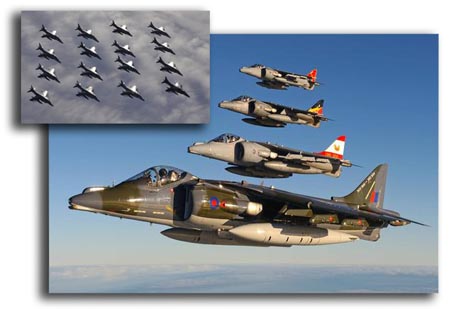A diamond-formation  flyby of 16 Harrier GR.7/GR.9 aircraft last week over RAF Cottesmore in eastern England, ceremoniously ended 41 years of Harrier service in the Royal Air Force and Royal Navy. Air Vice-Marshal Greg Bagwell, commander of the RAF’s No 1 Group, called the Harrier a “testament to the innovation and excellence of British design” that “takes its place in history as one of aviation’s greats.” The Harrier’s brisk retirement follows on the heels of sweeping cuts to British defense forces announced in October. As part of the retirement ceremony, four Harriers received retro paint schemes depicting the aircraft’s service over the years from defense of the Falklands in 1982 to operations in Afghanistan. The US Marine Corps still operates a Harrier variant, the BAE-McDonald Douglas (now Boeing) AV-8B Harrier II, an outgrowth of the original Hawker Siddley design. (Includes MOD release)
flyby of 16 Harrier GR.7/GR.9 aircraft last week over RAF Cottesmore in eastern England, ceremoniously ended 41 years of Harrier service in the Royal Air Force and Royal Navy. Air Vice-Marshal Greg Bagwell, commander of the RAF’s No 1 Group, called the Harrier a “testament to the innovation and excellence of British design” that “takes its place in history as one of aviation’s greats.” The Harrier’s brisk retirement follows on the heels of sweeping cuts to British defense forces announced in October. As part of the retirement ceremony, four Harriers received retro paint schemes depicting the aircraft’s service over the years from defense of the Falklands in 1982 to operations in Afghanistan. The US Marine Corps still operates a Harrier variant, the BAE-McDonald Douglas (now Boeing) AV-8B Harrier II, an outgrowth of the original Hawker Siddley design. (Includes MOD release)
The U.S. began extensive air and artillery strikes against Islamic State group targets in Syria on Dec. 19 in retaliation for the killing of three Americans on Dec. 13 by a gunman affiliated with ISIS, U.S. officials said.

